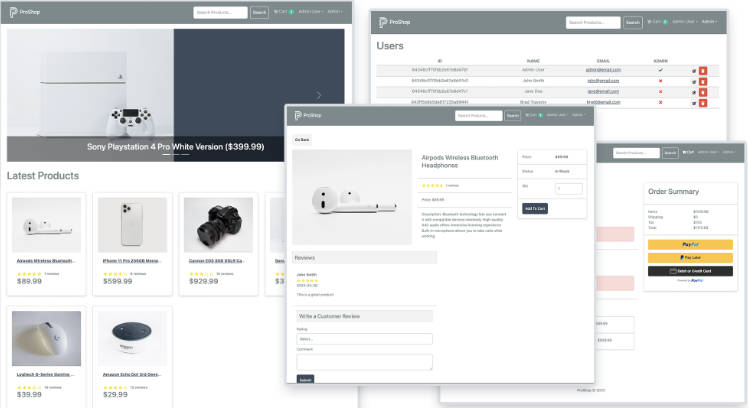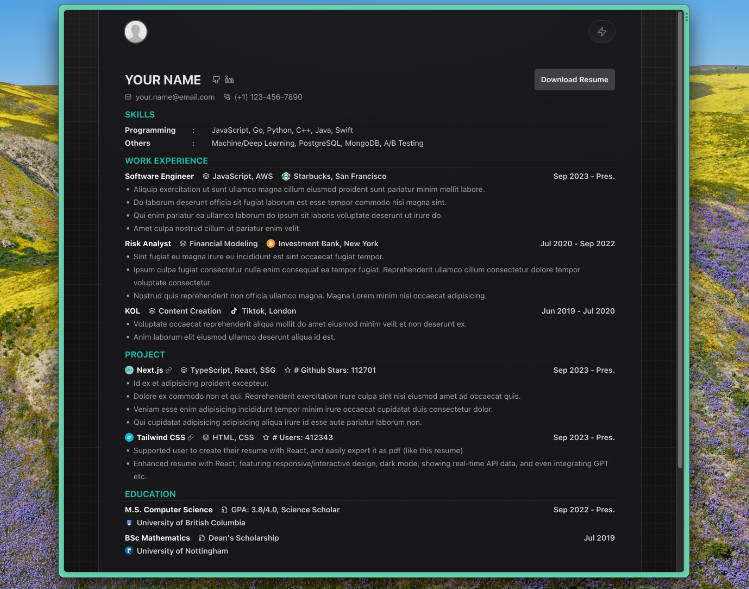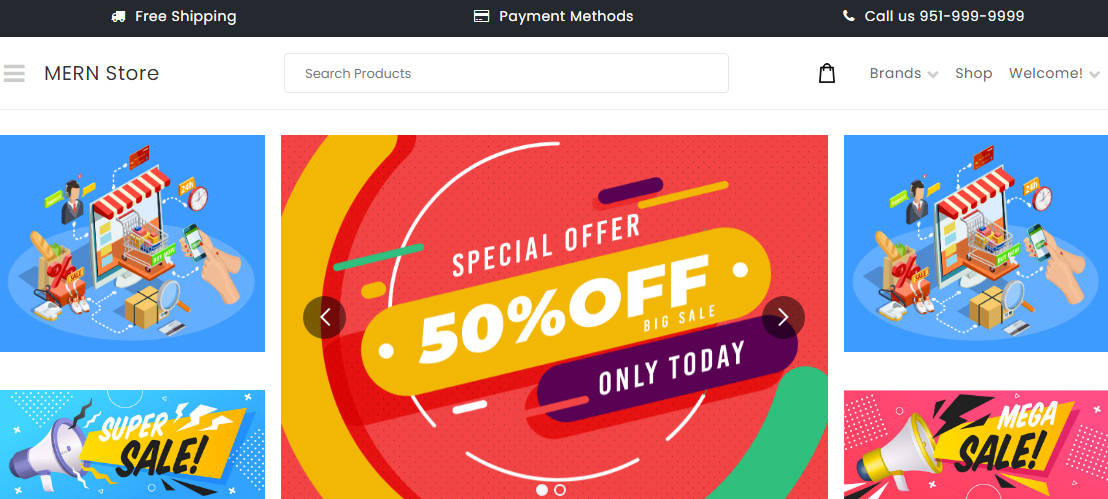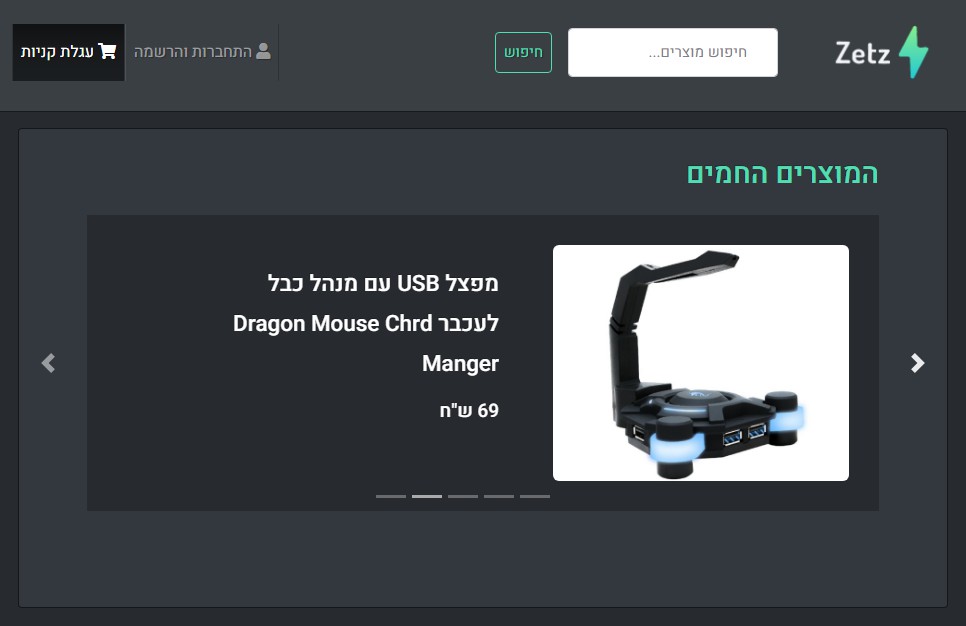ProShop eCommerce Platform (v2)
eCommerce platform built with the MERN stack & Redux.

This project is part of my MERN Stack From Scratch | eCommerce Platform course. It is a full-featured shopping cart with PayPal & credit/debit payments. See it in action at https://www.proshopdemo.dev
This is version 2.0 of the app, which uses Redux Toolkit. The first version can be found here
Features
- Full featured shopping cart
- Product reviews and ratings
- Top products carousel
- Product pagination
- Product search feature
- User profile with orders
- Admin product management
- Admin user management
- Admin Order details page
- Mark orders as delivered option
- Checkout process (shipping, payment method, etc)
- PayPal / credit card integration
- Database seeder (products & users)
Usage
- Create a MongoDB database and obtain your
MongoDB URI– MongoDB Atlas - Create a PayPal account and obtain your
Client ID– PayPal Developer
Env Variables
Rename the .env.example file to .env and add the following
NODE_ENV = development
PORT = 5000
MONGO_URI = your mongodb uri
JWT_SECRET = 'abc123'
PAYPAL_CLIENT_ID = your paypal client id
PAGINATION_LIMIT = 8
Change the JWT_SECRET and PAGINATION_LIMIT to what you want
Install Dependencies (frontend & backend)
npm install
cd frontend
npm install
Run
# Run frontend (:3000) & backend (:5000)
npm run dev
# Run backend only
npm run server
Build & Deploy
# Create frontend prod build
cd frontend
npm run build
Seed Database
You can use the following commands to seed the database with some sample users and products as well as destroy all data
# Import data
npm run data:import
# Destroy data
npm run data:destroy
Sample User Logins
[email protected] (Admin)
123456
[email protected] (Customer)
123456
[email protected] (Customer)
123456
Bug Fixes, corrections and code FAQ
The code here in the main branch has been updated since the course was published to fix bugs found by students of the course and answer common questions, if you are looking to compare your code to that from the course lessons then please refer to the originalcoursecode branch of this repository.
There are detailed notes in the comments that will hopefully help you understand and adopt the changes and corrections. An easy way of seeing all the changes and fixes is to use a note highlighter extension such as This one for VSCode or this one for Vim Where by you can easily list all the NOTE: and FIX: tags in the comments.
BUG: Warnings on ProfileScreen
We see the following warning in the browser console..
<tD> cannot appear as a child of <tr>.
and
warning: Received 'true' for a non-boolean attribute table.
Code changes can be seen in ProfileScreen.jsx
BUG: Changing an uncontrolled input to be controlled
In our SearchBox input, it’s possible that our urlKeyword is undefined, in
which case our initial state will be undefined and we will have an
uncontrolled input initially i.e. not bound to state.
In the case of urlKeyword being undefined we can set state to an empty
string.
Code changes can be seen in SearchBox.jsx
BUG: All file types are allowed when updating product images
When updating and uploading product images as an Admin user, all file types are allowed. We only want to upload image files. This is fixed by using a fileFilter function and sending back an appropriate error when the wrong file type is uploaded.
You may see that our checkFileType function is declared but never actually
used, this change fixes that. The function has been renamed to fileFilter and
passed to the instance of multer
Code changes can be seen in uploadRoutes.js
BUG: Throwing error from productControllers will not give a custom error response
In section 3 – Custom Error Middleware we throw an error from our
getProductById controller function, with a custom message.
However if we have a invalid ObjectId as req.params.id and use that to
query our products in the database, Mongoose will throw an error before we
reach the line of code where we throw our own error.
Original code
const getProductById = asyncHandler(async (req, res) => {
const product = await Product.findById(req.params.id);
if (product) {
return res.json(product);
}
// NOTE: the following will never run if we have an invalid ObjectId
res.status(404);
throw new Error('Resource not found');
});
Instead what we can do is if we do want to check for an invalid ObjectId is use a built in method from Mongoose – isValidObjectId There are a number of places in the project where we may want to check we are getting a valid ObjectId, so we can extract this logic to it’s own middleware and drop it in to any route handler that needs it. This also removes the need to check for a cast error in our errorMiddleware and is a little more explicit in checking fo such an error.
Changes can be seen in errorMiddleware.js, productRoutes.js, productController.js and checkObjectId.js
BUG: Bad responses not handled in the frontend
There are a few cases in our frontend where if we get a bad response from our API then we try and render the error object. This you cannot do in React – if you are seeing an error along the lines of Objects are not valid as a React child and the app breaks for you, then this is likely the fix you need.
Example from PlaceOrderScreen.jsx
<ListGroup.Item>
{error && <Message variant='danger'>{error}</Message>}
</ListGroup.Item>
In the above code we check for a error that we get from our useMutation hook. This will be an object though which we cannot render in React, so here we need the message we sent back from our API server…
<ListGroup.Item>
{error && <Message variant='danger'>{error.data.message}</Message>}
</ListGroup.Item>
The same is true for handling errors from our RTK queries.
Changes can be seen in:-
BUG: After switching users, our new user gets the previous users cart
When our user logs out we clear userInfo and expirationTime from local storage but not the cart. So when we log in with a different user, they inherit the previous users cart and shipping information.
The solution is to simply clear local storage entirely and so remove the cart, userInfo and expirationTime.
Changes can be seen in:-
BUG: Passing a string value to our addDecimals function
Our addDecimals function expects a Number type as an argument so calling
it by passing a String type as the argument could produce some issues.
It kind of works because JavaScript type coerces the string to a number when we
try to use mathematic operators on strings. But this is prone to error and can
be improved.
Changes can be seen in:
BUG: Token and Cookie expiration not handled in frontend
The cookie and the JWT expire after 30 days. However for our private routing in the client our react app simply trusts that if we have a user in local storage, then that user is authenticated. So we have a situation where in the client they can access private routes, but the API calls to the server fail because there is no cookie with a valid JWT.
The solution is to wrap/customize the RTK baseQuery with our own custom functionality that will log out a user on any 401 response
Changes can be seein in:
Additionally we can remove the following code:
const expirationTime = new Date().getTime() + 30 * 24 * 60 * 60 * 1000; // 30 days
localStorage.setItem('expirationTime', expirationTime);
from our authSlice.js as it’s never actually used in the project in any way.
FAQ: How do I use Vite instead of CRA?
Ok so you’re at Section 1 – Starting The Frontend in the course and you’ve heard cool things about Vite and why you should use that instead of Create React App in 2023.
There are a few differences you need to be aware of using Vite in place of CRA here in the course after scaffolding out your Vite React app
Setting up the proxy
Using CRA we have a "proxy" setting in our frontend/package.json to avoid
breaking the browser Same Origin Policy in development.
In Vite we have to set up our proxy in our
vite.config.js.
import { defineConfig } from 'vite';
import react from '@vitejs/plugin-react';
export default defineConfig({
plugins: [react()],
server: {
// proxy requests prefixed '/api' and '/uploads'
proxy: {
'/api': 'http://localhost:5000',
'/uploads': 'http://localhost:5000',
},
},
});
Setting up linting
By default CRA outputs linting from eslint to your terminal and browser console. To get Vite to ouput linting to the terminal you need to add a plugin as a development dependency…
npm i -D vite-plugin-eslint
Then add the plugin to your vite.config.js
import { defineConfig } from 'vite';
import react from '@vitejs/plugin-react';
// import the plugin
import eslintPlugin from 'vite-plugin-eslint';
export default defineConfig({
plugins: [
react(),
eslintPlugin({
// setup the plugin
cache: false,
include: ['./src/**/*.js', './src/**/*.jsx'],
exclude: [],
}),
],
server: {
proxy: {
'/api': 'http://localhost:5000',
'/uploads': 'http://localhost:5000',
},
},
});
By default the eslint config that comes with a Vite React project treats some rules from React as errors which will break your app if you are following Brad exactly. You can change those rules to give a warning instead of an error by modifying the eslintrc.cjs that came with your Vite project.
module.exports = {
env: { browser: true, es2020: true },
extends: [
'eslint:recommended',
'plugin:react/recommended',
'plugin:react/jsx-runtime',
'plugin:react-hooks/recommended',
],
parserOptions: { ecmaVersion: 'latest', sourceType: 'module' },
settings: { react: { version: '18.2' } },
plugins: ['react-refresh'],
rules: {
// turn this one off
'react/prop-types': 'off',
// change these errors to warnings
'react-refresh/only-export-components': 'warn',
'no-unused-vars': 'warn',
},
};
Vite outputs the build to /dist
Create React App by default outputs the build to a /build directory and this is what we serve from our backend in production. Vite by default outputs the build to a /dist directory so we need to make some adjustments to our backend/server.js Change…
app.use(express.static(path.join(__dirname, '/frontend/build')));
to…
app.use(express.static(path.join(__dirname, '/frontend/dist')));
and…
app.get('*', (req, res) =>
res.sendFile(path.resolve(__dirname, 'frontend', 'build', 'index.html'))
);
to…
app.get('*', (req, res) =>
res.sendFile(path.resolve(__dirname, 'frontend', 'dist', 'index.html'))
);
Vite has a different script to run the dev server
In a CRA project you run npm start to run the development server, in Vite you
start the development server with npm run dev
If you are using the dev script in your root pacakge.json to run the project
using concurrently, then you will also need to change your root package.json
scripts from…
"client": "npm start --prefix frontend",
to…
"client": "npm run dev --prefix frontend",
Or you can if you wish change the frontend/package.json scripts to use npm start…
"start": "vite",
A final note:
Vite requires you to name React component files using the .jsx file
type, so you won’t be able to use .js for your components. The entry point to
your app will be in main.jsx instead of index.js
And that’s it! You should be good to go with the course using Vite.
License
The MIT License
Copyright (c) 2023 Traversy Media https://traversymedia.com
Permission is hereby granted, free of charge, to any person obtaining a copy of this software and associated documentation files (the “Software”), to deal in the Software without restriction, including without limitation the rights to use, copy, modify, merge, publish, distribute, sublicense, and/or sell copies of the Software, and to permit persons to whom the Software is furnished to do so, subject to the following conditions:
The above copyright notice and this permission notice shall be included in all copies or substantial portions of the Software.
THE SOFTWARE IS PROVIDED “AS IS”, WITHOUT WARRANTY OF ANY KIND, EXPRESS OR IMPLIED, INCLUDING BUT NOT LIMITED TO THE WARRANTIES OF MERCHANTABILITY, FITNESS FOR A PARTICULAR PURPOSE AND NONINFRINGEMENT. IN NO EVENT SHALL THE AUTHORS OR COPYRIGHT HOLDERS BE LIABLE FOR ANY CLAIM, DAMAGES OR OTHER LIABILITY, WHETHER IN AN ACTION OF CONTRACT, TORT OR OTHERWISE, ARISING FROM, OUT OF OR IN CONNECTION WITH THE SOFTWARE OR THE USE OR OTHER DEALINGS IN THE SOFTWARE.





